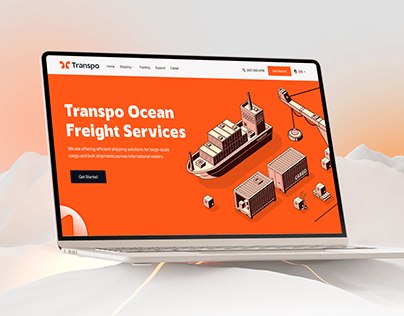The logistics and transportation industry is constantly evolving, with businesses striving to meet customer demands for efficiency, reliability, and seamless experiences. In this digital era, having a well-designed website is essential for transportation companies to stay competitive, attract customers, and streamline operations. Smart web design can significantly enhance user experience, improve engagement, and boost conversions.
In this article, we will explore how effective transportation web design can transform your logistics and transportation services, providing better accessibility, branding, and functionality for both businesses and customers.
1. Enhancing User Experience with Intuitive Navigation
A well-structured and intuitive website allows users to find the information they need quickly and efficiently. Logistics and transportation companies often have complex service offerings, including freight services, vehicle rentals, shipping tracking, and more. Smart web design ensures:
- Simple, clear navigation menus: Users should be able to find relevant services, pricing, and booking options within seconds.
- Search functionality: A powerful search tool allows users to look for specific services or track shipments effortlessly.
- Logical information hierarchy: Organizing content logically enhances usability and helps visitors navigate with ease.
2. Mobile-Friendly Design for On-the-Go Accessibility
Many customers in the transportation industry rely on mobile devices to access services, track shipments, and make bookings. A responsive, mobile-friendly web design ensures that your website adapts to all screen sizes, providing a seamless experience. This includes:
- Responsive layouts that adjust based on device type (smartphones, tablets, desktops).
- Mobile-optimized buttons and forms for easy interactions.
- Fast-loading pages to minimize wait times and reduce bounce rates.
3. Streamlining Online Bookings and Scheduling
A modern transportation web design should include an easy-to-use booking and scheduling system. This feature allows users to reserve transportation services, schedule deliveries, and check availability in real time. Key elements of an efficient booking system include:
- Automated booking confirmations and notifications to keep customers informed.
- User-friendly forms that minimize steps and collect necessary details efficiently.
- Integration with fleet management software to streamline operations.
4. Implementing Real-Time Tracking and Customer Portals
One of the most critical features for logistics and transportation businesses is real-time tracking. Customers want visibility into their shipments, estimated delivery times, and status updates. Smart web design incorporates:
- Live tracking maps that show the location of shipments or vehicles.
- Secure customer portals where users can log in to view their booking history, invoices, and tracking details.
- Automated status updates via email or SMS to keep customers informed.
5. SEO Optimization for Greater Visibility
A well-designed website is useless if potential customers can’t find it. Search Engine Optimization (SEO) ensures your transportation company ranks higher in search results, attracting more visitors. Some key SEO strategies include:
- Using relevant keywords, such as “transportation web design,” in website content, meta descriptions, and headers.
- Creating high-quality content, like blogs, guides, and case studies, that address customer pain points.
- Optimizing website speed and performance to improve search rankings.
6. Showcasing Customer Testimonials and Case Studies
Trust and credibility play a crucial role in choosing a transportation service provider. A smart web design includes sections for customer reviews, testimonials, and case studies to build confidence in your brand. These elements:
- Highlight real experiences from satisfied customers.
- Provide social proof that reassures potential clients.
- Establish your company as a reliable and reputable service provider.
7. Secure and Reliable Payment Options
For logistics and transportation companies that accept online payments, having a secure and reliable payment system is essential. Implementing multiple payment options, such as credit cards, PayPal, and digital wallets, enhances convenience. Best practices include:
- SSL encryption to protect customer payment data.
- Integration with trusted payment gateways for seamless transactions.
- Clear refund and cancellation policies to avoid customer disputes.
8. Optimizing Website Speed and Performance
A slow-loading website can frustrate visitors and lead to lost business. Ensuring optimal website performance includes:
- Compressing images and videos to reduce file sizes.
- Using caching techniques to speed up page loading times.
- Eliminating unnecessary scripts and plugins that slow down performance.
9. Integrating Social Media and Customer Support
A smart web design connects your website with social media platforms to increase engagement and brand awareness. Additionally, integrating customer support features improves service quality. Effective strategies include:
- Adding social media buttons to encourage sharing and interaction.
- Embedding live chat or chatbot support for instant assistance.
- Providing FAQ sections and help centers to address common customer inquiries.
10. Keeping Your Website Updated and Secure
Regular updates and security measures are essential to maintaining a reliable website. Cyber threats can compromise user data and damage your business reputation. Implementing security best practices includes:
- Regular software and plugin updates to prevent vulnerabilities.
- Data encryption and firewall protection to enhance security.
- Frequent website backups to restore data in case of any issues.
Conclusion
A well-executed transportation web design can revolutionize your logistics and transportation services by enhancing user experience, improving operational efficiency, and increasing customer satisfaction. By focusing on mobile responsiveness, intuitive navigation, real-time tracking, SEO optimization, and security, you can create a website that not only attracts visitors but also converts them into loyal customers.
If you’re looking to upgrade your transportation website and boost your online presence, investing in professional web design is the way to go. A well-designed website is not just a digital asset—it’s a powerful tool that can drive growth and success in the transportation industry.
Read More Blog – https://travelovisa.com/



